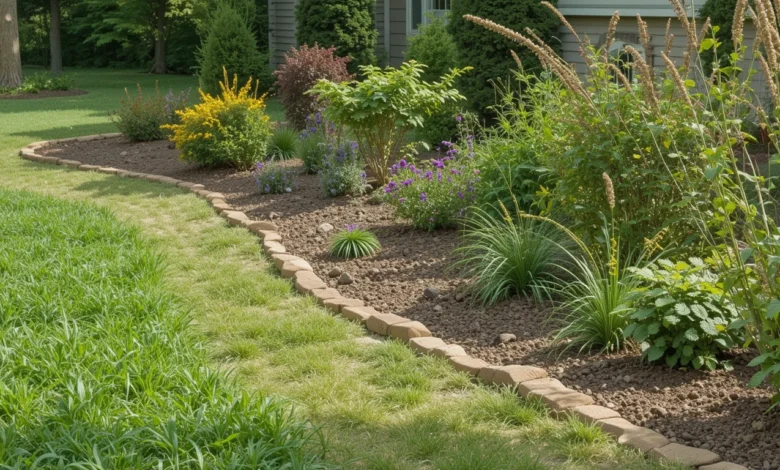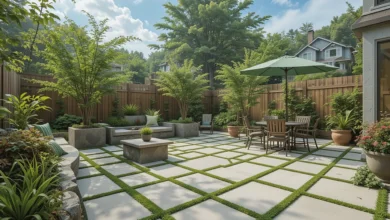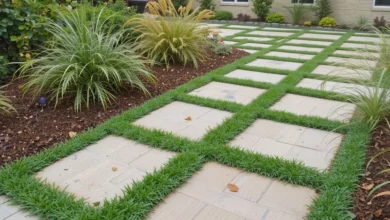Everything You Need to Know About Landscape Edging

Introduction When it comes to creating a beautiful garden or outdoor space, landscaping is key. One of the most important elements of landscaping is landscape edging. If you’ve ever seen a garden with neat lines between the flower beds and the lawn or pathways, that’s likely thanks to landscaping edging. It’s a simple yet effective way to define the boundaries of different areas in your yard.
In this article, we’ll take you through everything you need to know about landscape edging. From why it’s important to how to choose the right type for your garden, you’ll learn all the tips and tricks to make your outdoor space look tidy and attractive.
What Is Landscape Edging?
Landscape edging is the process of installing materials along the border of flower beds, lawns, or other garden areas to create clean, defined lines. It serves both practical and aesthetic purposes. Edging helps separate different areas of your garden, like the grass and the flower beds, while also preventing grass and weeds from spreading into your garden beds.
In addition to its functional benefits, landscape edging can also add to the beauty of your garden. By creating crisp, sharp borders, you can enhance the visual appeal of your garden design and give it a polished, professional look.
Why Is Landscape Edging Important?
There are several reasons why landscape edging is a great idea for your garden:
- Prevents Grass and Weeds from Spreading: One of the main benefits of edging is that it prevents grass, weeds, and other unwanted plants from growing into your flower beds or garden areas. This makes it easier to maintain your garden and reduces the need for constant weeding.
- Defines Boundaries: Edging creates a clear boundary between different areas of your garden. It separates flower beds, lawns, walkways, and other spaces, making the garden look more organized and tidy.
- Improves Curb Appeal: Landscape edging adds a finishing touch to your garden and enhances its overall appearance. A well-edged garden looks more polished and inviting, which can increase the curb appeal of your home.
- Reduces Maintenance: By keeping the edges of your garden neat and tidy, you’ll spend less time trimming grass and pulling weeds. Edging helps to reduce the growth of unwanted grass and makes it easier to maintain clean lines between your garden beds and lawn.
- Protects Your Plants: Edging can also protect your plants by keeping them from being trampled or damaged by foot traffic. It acts as a barrier that helps prevent people or pets from accidentally stepping into delicate areas of your garden.
Types of Landscape Edging
There are many different materials you can use for landscape edging. The right choice for you will depend on your budget, the style of your garden, and how much maintenance you want to do. Let’s take a look at some of the most popular options:
1. Plastic Edging
Plastic edging is one of the most affordable and easiest materials to install. It’s flexible, durable, and available in various styles, including straight, curved, or scalloped edges. Plastic edging is often used for flower beds, lawns, and pathways.
Pros:
- Easy to install
- Inexpensive
- Available in different colors and styles
Cons:
- May not be as aesthetically appealing as other materials
- Can crack or fade over time when exposed to sunlight
2. Metal Edging
Metal edging is a strong and long-lasting option for landscape design. It is typically made from steel or aluminum and is often used in modern or minimalist gardens. Metal edging is more expensive than plastic, but it can last for many years and gives a sleek, clean look to your garden.
Pros:
- Durable and long-lasting
- Provides a sleek, modern look
- Available in different finishes like galvanized steel, aluminum, or corten steel
Cons:
- More expensive than plastic
- Can be difficult to install, especially for beginners
3. Wood Edging
Wood edging is a natural option that can blend seamlessly with your garden design. It’s often used in rustic, traditional, or cottage-style gardens. You can use timber planks, wooden logs, or treated landscape timbers to create a border for your garden.
Pros:
- Natural and blends well with most garden styles
- Easy to install for DIY gardeners
- Affordable if using reclaimed wood
Cons:
- Requires regular maintenance to prevent rot
- Not as durable as metal or plastic options
4. Brick or Stone Edging
Brick and stone edging offer a timeless and elegant look. They can be used to create both formal and informal garden designs. These materials are more expensive than plastic or wood but provide a sturdy, permanent border that will last for years.
Pros:
- Classic, elegant appearance
- Extremely durable
- Can create both straight and curved lines
Cons:
- Expensive compared to plastic and wood
- Requires professional installation if you want it done correctly
5. Rubber Edging
Rubber edging is an eco-friendly option made from recycled materials. It’s often used in garden areas that require a flexible edging solution. Rubber is durable and can withstand the elements without cracking or fading. It’s also easier to install than stone or brick.
Pros:
- Eco-friendly
- Flexible and easy to install
- Resistant to weathering and fading
Cons:
- Limited design options
- Can be more expensive than plastic
6. Concrete Edging
Concrete edging is one of the most permanent and durable options available. You can either pour concrete yourself or use pre-formed concrete blocks or pavers. Concrete provides a clean and professional look and is often used in formal gardens or landscaping projects.
Pros:
- Extremely durable and long-lasting
- Can be molded into any shape
- Provides a clean, modern look
Cons:
- Expensive and labor-intensive to install
- Requires professional help unless you’re skilled in concrete work
How to Install Landscape Edging
Installing landscape edging is a straightforward process, but the steps can vary depending on the type of edging material you choose. Here’s a general step-by-step guide:
Read More: When to Mow Your Lawn After Winter for Healthy Grass
- Plan Your Design: Decide where you want to place the edging. Use a garden hose or string to lay out the borders and create the desired shape. You can go for straight lines or curves depending on your garden style.
- Mark the Edging Line: Once you’ve planned the design, mark the area where the edging will go using stakes or spray paint.
- Dig a Trench: Use a shovel to dig a shallow trench along the marked line. The trench should be deep enough to accommodate the edging material. For most types of edging, a depth of 2-3 inches is sufficient.
- Install the Edging: Follow the manufacturer’s instructions for your chosen material. For example, if you’re using plastic or rubber edging, you may need to stake it into the ground. If you’re using bricks or stone, you’ll need to lay them in place and secure them with mortar or sand.
- Fill and Compact the Soil: After the edging is installed, fill the trench with soil and compact it to ensure the edging stays in place.
- Add Mulch or Gravel: To complete the look, you can add mulch, gravel, or another decorative element around the base of the edging to create a clean and finished appearance.
Tips for Maintaining Landscape Edging
Once your landscape edging is installed, there are a few maintenance tasks to keep it looking great:
- Trim Grass and Weeds: Regularly trim the grass that grows along the edge of your garden and remove any weeds to prevent them from invading your flower beds.
- Check for Shifting Edging: Over time, some types of edging may shift or move. Periodically check your edging and adjust it if necessary.
- Clean and Reseal: If you’re using materials like wood or stone, clean them regularly and reseal them to protect them from the elements.
- Replace Damaged Edging: If any part of your edging becomes damaged or worn out, replace it promptly to maintain the clean, organized look of your garden.
Conclusion
Landscape edging is an essential element in creating a tidy, well-maintained garden. Whether you choose plastic, wood, stone, or another material, the right edging can help define garden borders, keep your lawn neat, and add beauty to your outdoor space. It also reduces maintenance by keeping unwanted grass and weeds at bay.
By choosing the right material for your garden style and following the installation and maintenance tips provided, you can create a garden that looks professional and is easy to care for. Start edging today, and watch your garden transform into a beautifully organized space.




